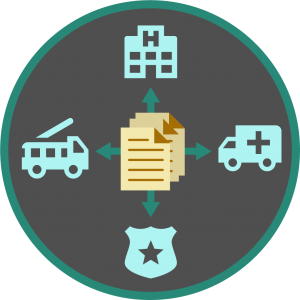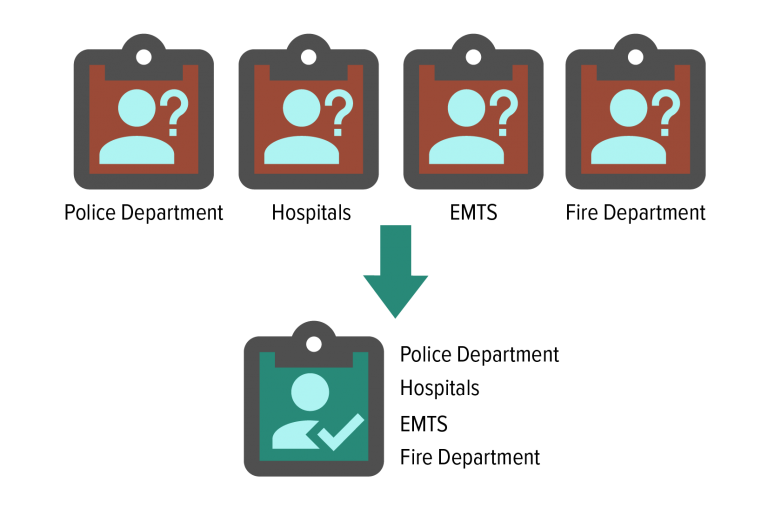Improving Public Health Services through Data Sharing

Problem
 When first line responders and service providers interact with a client to address a mental health crisis, they often do so without knowing which services or contacts the client has interacted with in the past. Examples include the local hospital emergency room, behavioral health providers, law enforcement, social services, and homeless services. This disconnect creates difficulty for responders and service providers in understanding the client’s holistic well-being, prior services, and what service they need next. This also creates an experience for the client that is inconsistent and frustrating and requires them to repeatedly fill out duplicate paperwork and work with each new provider starting over each time. This leads the client to struggle continuously to find the right treatment and care among the numerous different organizations available to them and leaves the responders and service providers in a similar position. Sharing client information between these organizations ethically can help the system to address a client’s needs comprehensively by getting them the right care at the right time and help the client break the cycle they may be in.
When first line responders and service providers interact with a client to address a mental health crisis, they often do so without knowing which services or contacts the client has interacted with in the past. Examples include the local hospital emergency room, behavioral health providers, law enforcement, social services, and homeless services. This disconnect creates difficulty for responders and service providers in understanding the client’s holistic well-being, prior services, and what service they need next. This also creates an experience for the client that is inconsistent and frustrating and requires them to repeatedly fill out duplicate paperwork and work with each new provider starting over each time. This leads the client to struggle continuously to find the right treatment and care among the numerous different organizations available to them and leaves the responders and service providers in a similar position. Sharing client information between these organizations ethically can help the system to address a client’s needs comprehensively by getting them the right care at the right time and help the client break the cycle they may be in.
Innovation in Action
An innovation workshop was performed with organizational representation from the relevant Iowa City stakeholders and the Cal Poly Digital Transformation Hub (DxHub). The goal was to co-design a data sharing workflow leveraging the insights and expertise from many different key entities including: County Ambulance Service, Department of Public Health, City Council, the local University Hospital system, the County Crisis Center, law enforcement, and others. The group discussed the problem and experience from the first line responder (paramedic, ER nurse, etc) perspective as well as the perspective of the client in crisis. A new user and client experience was designed to streamline the workflow and demonstrate a more effective outcome for all stakeholders. See the storyboard below for a better understanding.

Next Steps
Iowa City has chosen to work with a secure, cloud-based data platform called Open Lattice (www.openlattice.com) to demonstrate the initial data sharing workflows as described in the artifacts linked below. DxHub staff are in discussions with the Iowa City team and OpenLattice to build a proof-of-concept application, InterConnect, that will access the data through an API (application programming interface) and demonstrate a streamlined workflow for end users. This will help Iowa City’s various stakeholders to validate the concept and appreciate the tangible benefits of data sharing and coordination when responding to a mental health crisis
Supporting Documents
| Press Release & Frequently Asked Questions | During the Innovation Workshop, a fictional Press Release and nonfictional Frequently Asked Questions are drafted. This is a tool that is used to define the solution and why it matters to the customer. |
| Storyboard | A series of frames designed to illustrate the problem and the impact of the solution visually. |
About the DxHub
The Cal Poly Digital Transformation Hub (DxHub) is a strategic relationship with Amazon Web Services (AWS) and is the world’s first cloud innovation center supported by AWS on a University campus. The primary goal of the DxHub is to provide real-world problem-solving experiences to students by immersing them in the application of proven innovation methods in combination with the latest technologies to solve important challenges in the public sector. The challenges being addressed cover a wide variety of topics including homelessness, evidence-based policing, digital literacy, virtual cybersecurity laboratories and many others. The DxHub leverages the deep subject matter expertise of government, education and non-profit organizations to clearly understand the customers affected by public sector challenges and develops solutions that meet the customer needs.
